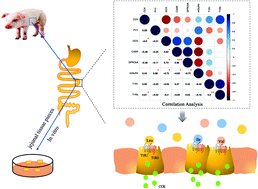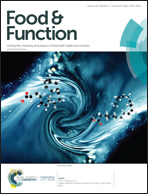Branched chain amino acids stimulate gut satiety hormone cholecystokinin secretion through activation of the umami taste receptor T1R1/T1R3 using an in vitro porcine jejunum model†
Abstract
Branched chain amino acids (BCAAs) are essential amino acids involved in regulation of feed intake. The function of BCAAs on the central nervous system has been extensively studied, but effects of BCAAs on secretion of gut satiety hormones and their underlying mechanisms are largely unknown. In this study, we evaluated the distribution of gut hormones and amino acid receptors in the porcine GI tract and found cholecystokinin (CCK) and taste dimeric receptor type 1 member 1/3 (T1R1/T1R3) were predominantly expressed in the jejunum and functionally interrelated. We further evaluated the effects of L-leucine, L-isoleucine, L-valine, and BCAAs on CCK and T1R1/T1R3 expression in porcine jejunum tissue. Our data demonstrated that stimulation of porcine jejunum tissue with 10 mM L-leucine, L-isoleucine or BCAAs mix (L-leucine : L-isoleucine : L-valine = 1 : 0.51 : 0.63) for 2 hours significantly increased mRNA expression and protein abundance of T1R1/T1R3 and secretion of CCK (P < 0.05). However, the L-valine treatment only increased the mRNA and protein abundance of T1R1 and T1R3 (P < 0.05), but not CCK secretion (P > 0.10). L-Leucine-, L-isoleucine- or BCAAs mix-induced CCK secretion was significantly decreased after tissues were pretreated with lactisole, a T1R1/T1R3 inhibitor (P < 0.05). Furthermore, the increased mRNA and protein abundance of T1R1/T1R3 were also largely attenuated by blocking T1R1/T1R3 with lactisole (P < 0.05). L-Leucine, L-isoleucine and BCAAs mix appeared to induce the gut satiety hormone CCK secretion through jejunal T1R1/T1R3. These results indicate over-supplementation with BCAAs in the diet might decrease food intake in swine and humans through gastrointestinal feedback.



 Please wait while we load your content...
Please wait while we load your content...